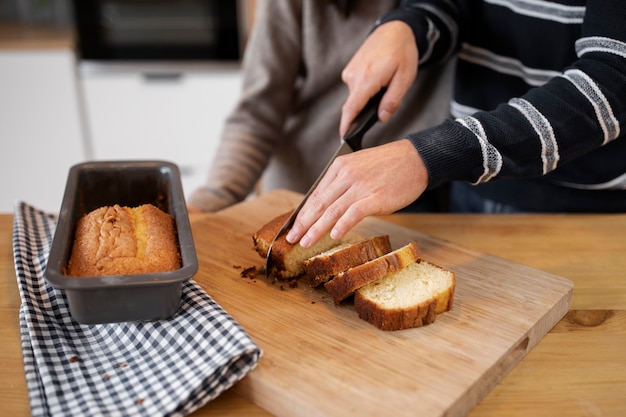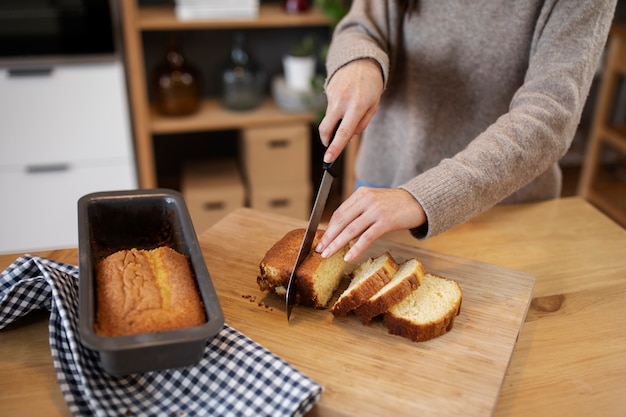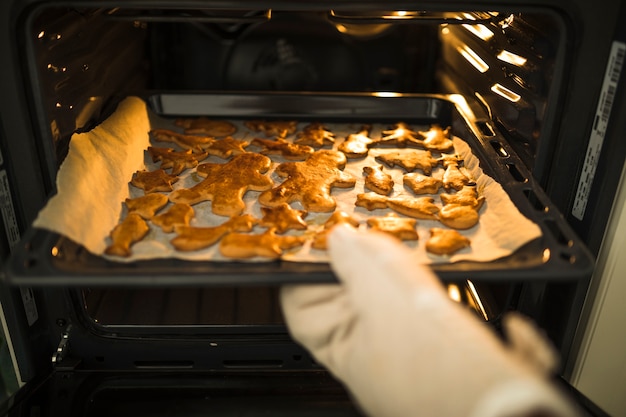Let's be honest, there's nothing quite like the smell of bacon sizzling in the pan. That salty, smoky aroma is enough to make anyone's mouth water. But, cooking bacon in a pan can be a bit of a chore. You're stuck there watching it, flipping it every few minutes, and it can easily burn if you're not careful. Then there's the mess to clean up afterwards! That's why I've become a huge fan of cooking bacon in the oven. It's a game-changer, I tell you!
Over the years, I've learned a few tricks to make sure my bacon comes out perfectly crispy every time. From choosing the right bacon to understanding the perfect cooking time and temperature, I've got all the tips and secrets you need to become a bacon-cooking pro. So, grab yourself a cup of tea, settle in, and let's get started!
(Part 1) Choosing the Right Bacon

Before you even think about turning on the oven, you need to pick the right bacon. This is the foundation of your bacon journey, after all! There are so many different types of bacon out there, but it really comes down to personal preference. Here's a breakdown of the most common options, along with my thoughts on each:
The Great british bacon Debate: Streaky vs. back bacon
Let's face it, here in the UK, the bacon world revolves around two main contenders: streaky and back bacon. streaky bacon, the one we're all familiar with, is thin and fatty. It's ideal for frying, baking, or even grilling. It's that perfect mix of crispy, salty, and fatty that I just can't resist! Then there's back bacon, which is thicker and leaner, with a more robust flavour. It's great for sandwiches, or as part of a classic full English breakfast.
While I’m a huge fan of streaky bacon, my friend Sarah swears by back bacon. She says it has a more meaty flavour, but for me, it lacks that delicious fat content that makes streaky bacon so irresistible.
Smoked or Unsmoked?
Next, we've got the smoky versus unsmoked debate. Both have their merits, and it really depends on your personal taste. smoked bacon has that classic smoky flavour that we all know and love. It's a bit more intense, and it's perfect for adding depth to your dishes. unsmoked bacon has a milder flavour, and it’s a good choice if you want to avoid that smoky taste.
Personally, I love a bit of smoke in my bacon, but I also appreciate a good unsmoked bacon for a more subtle flavour. I even sometimes use a mix of both when I'm making bacon for a crowd! It’s all about balance, you know?
Thickness Matters!
And lastly, don't underestimate the importance of bacon thickness! thick-cut bacon is a little more forgiving when it comes to cooking. It takes a bit longer to cook through, so it's less likely to burn. Thin-cut bacon can cook quicker, so it's a bit more delicate, but if you're careful, it can still be a great choice.
For me, a medium-thickness bacon is the sweet spot. It’s not too thick, not too thin, and it cooks perfectly in the oven every time. Plus, it's a good balance of crispy edges and juicy center.
(Part 2) Getting Ready to Cook

Now, you've got your bacon, and you're ready to start cooking. But, before you even turn on the oven, there are a few things you should do to make sure your bacon cooks perfectly. Let's start with the most important part: the oven!
Preheat Your Oven: A Crucial Step
This may seem obvious, but preheating your oven is crucial! It makes sure your bacon cooks evenly and helps prevent it from burning. Now, I know some people like to cook their bacon at low temperatures for a longer time, and that's totally fine. But, I like to crank up the heat and cook it fast. For me, 400°F (200°C) is the perfect temperature.
The Baking Sheet: Don't Forget the Liners!
You'll also need a baking sheet. I always line mine with parchment paper. This way, your bacon won't stick to the sheet, and you won't have a greasy mess to clean up. Plus, it makes for easy cleanup. You can thank me later!
Bacon on a Single Layer
This is super important! You want your bacon to cook evenly, so don't overcrowd the baking sheet. Spread it out in a single layer, making sure each piece has a bit of space to breathe. If you're cooking a lot of bacon, use two baking sheets.
(Part 3) Cooking Time: It's a Science (Sort Of)

Ok, so your oven is preheated, your bacon is ready, and you're ready to go. Let's talk about cooking time. This is where things can get tricky, because every oven is different, and every bacon is different. So, there's no magic number here, but I can give you a good starting point.
Average Bacon Baking Times
For most bacons, I usually cook them for about 15-20 minutes, turning them halfway through. But, I always check them after 15 minutes to make sure they're not burning. If you're using thicker bacon, you might need to cook it for a bit longer. And if you're using thin-cut bacon, you might need to watch it more closely because it can cook a lot faster.
The Perfect bacon texture: A Little Test
To check if your bacon is done, use a fork or a spatula to gently lift up one of the pieces. If it's crisp and the fat has rendered out, it's ready to go. If it's still a bit floppy, cook it for a few more minutes. Don't be afraid to test it every few minutes!
And remember, everyone has their preference. Some people like their bacon crispy, some like it chewy, and some like it somewhere in between. So, don't be afraid to experiment and find what you like best!
(Part 4) The crispy bacon Secret: Don’t Be Afraid to Flip
Here's my little secret for perfectly crispy bacon: flipping! It may seem like extra work, but flipping your bacon halfway through ensures that both sides cook evenly and get that beautiful, crispy texture. It also helps to prevent the bacon from curling up, which can make it unevenly cooked.
Flipping Technique
To flip your bacon, use a spatula or a pair of tongs to gently lift up each piece. Then, flip it over and place it back on the baking sheet. Try to avoid using your fingers because you’ll get greasy fingers. Honestly, it’s a real game-changer! It’s worth the extra effort.
(Part 5) The Great bacon fat Debate
Let's talk about the bacon fat. Yes, I know, we all love that glorious, salty, crispy bacon fat. But, it's important to be mindful of it. It's delicious, but it can also be a little unhealthy. So, what do we do?
Pouring Off the Bacon Fat
One option is to pour off the excess bacon fat after it's done cooking. You can do this by carefully tilting the baking sheet over a bowl or a saucepan. And remember, don't throw away the bacon fat! It can be used to make tons of delicious dishes, or even saved for later use.
The Paper Towel Trick
Another option is to drain the bacon on paper towels after it's cooked. This helps absorb some of the excess fat and makes the bacon a little less greasy. This is the method I usually use because it’s simple and effective!
Ultimately, it's up to you. Decide how much fat you want your bacon to have. Some people love the fatty bacon, and others prefer it lean. And if you're really serious about reducing the fat, you can even use a wire rack over a baking sheet to let the fat drip off during cooking.
(Part 6) Time to Eat!
Your bacon is cooked, it’s crispy, and you've drained off the fat. Time to enjoy it! And let’s be honest, you can eat it as is, straight off the baking sheet. But, there are endless ways to enjoy your crispy bacon. Here are a few of my favourite ways to enjoy bacon.
Bacon as a side dish
Of course, you can't go wrong with a classic side of bacon. Serve it up with a side of eggs, toast, or sausages for a hearty breakfast. I love adding a few pieces to my salads. It adds a bit of salty crunch that I just can't resist!
Bacon in Your Sandwiches and Burgers
For a gourmet sandwich or burger, add some crispy bacon! It's the perfect way to add a bit of saltiness, smokiness, and texture to your favourite burger or sandwich.
Bacon-Wrapped Delights
Wrap bacon around your favourite foods like chicken, shrimp, dates, or even asparagus. It's a great way to add flavour and a bit of extra crunch! And be sure to use toothpicks to keep those bacon wraps in place. It’s so much fun!
And let’s not forget about bacon bits! They are a great topping for soups, salads, and even pasta dishes. I also love to sprinkle them over my popcorn for a salty, smoky snack.
(Part 7) Bacon: A Culinary Masterpiece
There you have it, folks! My tips and tricks for cooking bacon to perfection in the oven. I know it might seem a bit daunting at first, but trust me, it's easier than you think. With a little practice, you'll be whipping up perfectly cooked bacon in no time.
And remember, the key is to experiment and find what you like best. Don’t be afraid to try different types of bacon, different cooking times, and different temperatures. Bacon is such a versatile ingredient; you can really do so much with it!
(Part 8) FAQs
Q1: What if my bacon is sticking to the baking sheet?
If your bacon is sticking to the baking sheet, it's probably because you didn't use parchment paper. Or, the parchment paper wasn’t properly greased. You can try flipping the bacon over halfway through cooking, or you can use a spatula or tongs to gently lift it off the baking sheet. Always line your baking sheet with parchment paper!
Q2: Can I cook bacon in a toaster oven?
Absolutely! You can cook bacon in a toaster oven, but you might need to adjust the cooking time and temperature. Check your toaster oven's instructions for recommended temperatures and cooking times. You’ll need to use a baking sheet or a wire rack for this.
Q3: Can I cook other things with the bacon fat?
Yes! Bacon fat is a delicious and versatile cooking fat. You can use it to fry eggs, saute vegetables, or even make a simple bacon fat gravy. It adds a delicious smoky flavour to your dishes.
Q4: What can I do with leftover bacon?
Leftover bacon can be added to salads, sandwiches, soups, or even used as a topping for pizza. Or, you can crumble it up and use it as a garnish. It’s so good! If you are worried about it going bad, you can freeze it to use later.
Q5: Can I cook bacon in the air fryer?
Yes, you can absolutely cook bacon in an air fryer! It's a great way to get crispy bacon without any mess. Most air fryers will come with an instruction manual, but I usually set my air fryer to 400°F (200°C) and cook my bacon for about 6-8 minutes. Check on the bacon a few times to make sure it’s cooking evenly.
I hope this guide has been helpful! Happy bacon cooking!
Everyone is watching

Prime Rib Roast Cooking Time Chart: Per Pound Guide
Cooking TipsPrime rib roast. Just the name conjures images of lavish dinners, crackling fires, and hearty laughter. It’s ...

How Long to Bake Potatoes in the Oven (Perfect Every Time)
Cooking TipsBaked potatoes are a staple in my kitchen. They're incredibly versatile, delicious, and surprisingly easy to m...

Perfect Rice Every Time: The Ultimate Guide to Cooking Rice
Cooking TipsAs a self-proclaimed foodie, I've always been a bit obsessed with rice. It's the foundation of countless cuisi...

The Ultimate Guide to Cooking Asparagus: Tips, Techniques, and Recipes
Cooking TipsAsparagus. The mere mention of this spring delicacy conjures up images of vibrant green spears, crisp and burs...

Ultimate Guide to Cooking the Perfect Thanksgiving Turkey
Cooking TipsThanksgiving. Just the word conjures up images of overflowing tables laden with delicious food, the scent of r...
